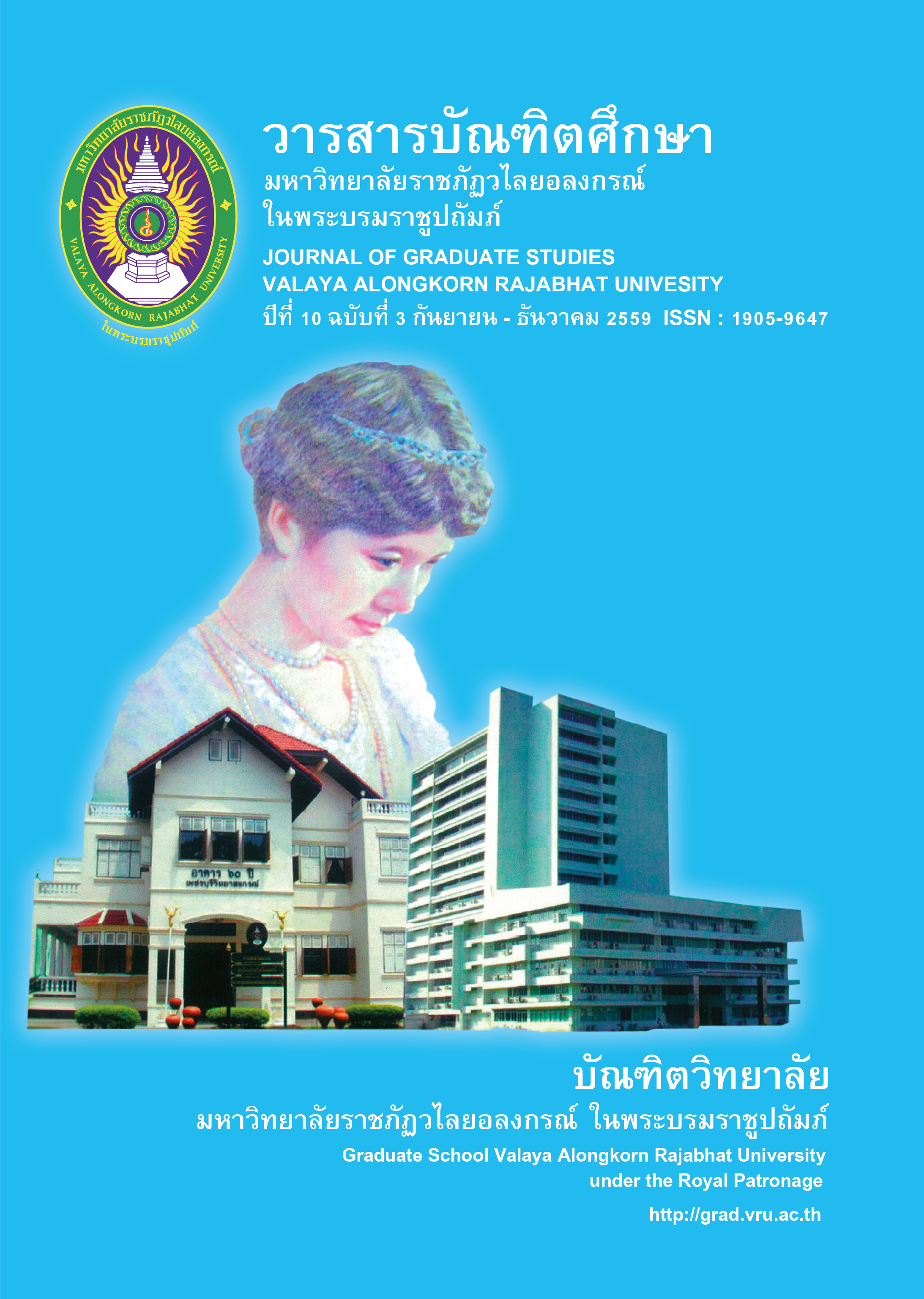ตัวแบบการขับเคลื่อนยุทธศาสตร์พลังงานไฟฟ้าสีเขียวเพื่อความยั่งยืนของการท่องเที่ยวเชิงนิเวศ
Main Article Content
Abstract
บทคัดย่อ
การวิจัยครั้งนี้มีวัตถุประสงค์เพื่อศึกษาตัวแบบการขับเคลื่อนยุทธศาสตร์พลังงานไฟฟ้าสีเขียวเพื่อการพัฒนาที่ยั่งยืนของการท่องเที่ยวเชิงนิเวศ และศึกษาความสัมพันธ์ของตัวแบบการขับเคลื่อนยุทธศาสตร์พลังงานไฟฟ้าสีเขียวกับความยั่งยืนของการท่องเที่ยวเชิงนิเวศ การวิจัยครั้งนี้เป็นการศึกษาวิจัยแบบผสานวิธี ทั้งกระบวนการวิจัยเชิงคุณภาพและกระบวนการวิจัยเชิงปริมาณทำการสังเคราะห์ตัวแปร เพื่อนำมากำหนดกรอบการวิจัย กลุ่มตัวอย่างในการวิจัยด้วยการสัมภาษณ์เชิงลึก ในกระบวนการวิจัยเชิงคุณภาพเป็นตัวแทนจากหน่วยงานภาครัฐที่เกี่ยวข้องกับการใช้ไฟฟ้าและการบริหารจัดการเกี่ยวกับการท่องเที่ยวในพื้นที่เกาะเสม็ด ตัวแทนจากผู้ประกอบการและผู้ประกอบธุรกิจต่าง ๆ ในพื้นที่เกาะเสม็ด และตัวแทนจากชุมชนผู้อยู่อาศัยในพื้นที่เกาะเสม็ด จังหวัดระยอง จำนวน 32 คน การวิเคราะห์ข้อมูลใช้โปรแกรมวิเคราะห์ข้อมูลเชิงคุณภาพ กระบวนการวิจัยเชิงปริมาณ โดยวิธี การวิจัยเชิงปริมาณด้วยการใช้แบบสอบถามกับกลุ่มตัวอย่างผู้ใช้ไฟฟ้าต่าง ๆ ในพื้นที่เกาะเสม็ด จังหวัดระยอง เป็นหน่วยงานภาครัฐที่เกี่ยวข้องกับการใช้ไฟฟ้าและการบริหารจัดการเกี่ยวกับการท่องเที่ยว ผู้ประกอบการและผู้ประกอบธุรกิจ และชุมชนผู้อยู่อาศัย จำนวน 336 คน การวิเคราะห์ข้อมูลใช้โปรแกรมสถิติเพื่อสังคมศาสตร์ในการวิเคราะห์ค่าสถิติพื้นฐาน และโปรแกรมสมการโครงสร้างในการวิเคราะห์โมเดลสมการโครงสร้าง (SEM) และนำโมเดลที่ค้นพบได้ไปทดสอบความพึงพอใจของนักท่องเที่ยว จำนวน 105 คน ที่อุทยานแห่งชาติหมู่เกาะช้าง จังหวัดตราด ผลการวิจัยปรากฏว่าตัวแบบของการขับเคลื่อนยุทธศาสตร์พลังงานไฟฟ้าสีเขียวเพื่อการพัฒนาที่ยั่งยืนของการท่องเที่ยวเชิงนิเวศ ประกอบด้วย นโยบายของรัฐบาลที่เกี่ยวกับพลังงานไฟฟ้าสีเขียวของประเทศไทยและต่างประเทศ และองค์ประกอบการขับเคลื่อนนโยบายพลังงานไฟฟ้าสีเขียวที่ยั่งยืนโมเดลสมการโครงสร้างตัวแบบของการขับเคลื่อนยุทธศาสตร์พลังงานไฟฟ้าสีเขียวเพื่อการพัฒนาที่ยั่งยืนของการท่องเที่ยวเชิงนิเวศมีความสอดคล้องกับข้อมูลเชิงประจักษ์อยู่ในเกณฑ์ดี โดยพิจารณาจากผลการตรวจสอบค่า Chi-square (X2) มีค่าเท่ากับ 149.442 ค่า df เท่ากับ 124 ค่าP-value เท่ากับ 0.060 GFI เท่ากับ 0.958 AGFI เท่ากับ 0.930 CFI เท่ากับ 0.997 และ RMSEA เท่ากับ 0.025 นักท่องเที่ยวมีความพึงพอใจในการใช้โมเดลตัวแบบในแหล่งท่องเที่ยวเชิงนิเวศที่อุทยานแห่งชาติหมู่เกาะช้าง จังหวัดตราด คิดเป็นร้อยละ 81.5 ซึ่งผลการวิเคราะห์ข้อมูลจะเป็นแนวทางในการพัฒนาที่ยั่งยืนของการท่องเที่ยวเชิงนิเวศ เพื่อนำไปดำเนินการและพัฒนา ให้เป็นประโยชน์ต่อไป
ABSTRACT
This research attempts to study green electrical energy strategic-driven approach for the sustainability of eco-tourism, and to study the relationship between green electrical energy strategic-driven approach and the sustainability of eco-tourism. This study is the mixed research study combing both qualitative and quantitative study to synchronize variables to determine conceptual framework. The subjects having in-depth interviews in qualitative research process. 32 subjects included representatives from government sectors related to the use of electricity and tourism management in Samed Island, representatives from entrepreneurs and business owners in SamedIslandas well as representatives from community residing in Samed Island, Rayong Province. The qualitative data and quantitative process were analyzed using software program. The questionnaires were distributed to collect quantitative data from 336 subjects who were electricity users in Samed Island, Rayong Province including government sectors related to the use of electricity and tourism management, entrepreneurs and business owners as well as residents in Samed Island, Rayong Province. Statistics software program for social sciences was applied to find basic statistics as well as Structural Equation Modeling (SEM) and the implementation of the discovered model to test the satisfaction from 105 tourists in Mu Koh Chang (Chang Islands), Trad Province. The findings reveal that model of green energy strategic-driven approach for the sustainability is a government policy and elements of driven energy policy. Structural Equation Modeling (SEM) of green energy strategic-driven approach for the sustainability of eco-tourism conformed to the empirical data at the good level by considering the values including 149.442 of Chi-square (X2), 124 of df value, 0.060 of P-value, 0.958 of GFI, 0.930 of AGFEI, 0.997 of CFI, and 0.025 of RMSEA. Tourists satisfied with the use of this model in eco-tourism area in Mu Koh Chang National Park, Trad Province at the percentage of 81.5. The findings of this analysis could be used as a guideline to develop sustainable eco-tourism and to operate and develop for further advantage.
Article Details

This work is licensed under a Creative Commons Attribution-NonCommercial-NoDerivatives 4.0 International License.
บทความทุกเรื่องได้รับการตรวจความถูกต้องทางวิชาการโดยผู้ทรงคุณวุฒิ ทรรศนะและข้อคิดเห็นในบทความ Journal of Global of Perspectives in Humanities and Social Sciences (J-GPHSS) มิใช่เป็นทรรศนะและความคิดของผู้จัดทำจึงมิใช่ความรับผิดชอบของบัณฑิตวิทยาลัย มหาวิทยาลัยราชภัฏวไลยอลงกรณ์ ในพระบรมราชูปถัมภ์ กองบรรณาธิการไม่สงวนสิทธิ์การคัดลอก แต่ให้อ้างอิงแหล่งที่มา


